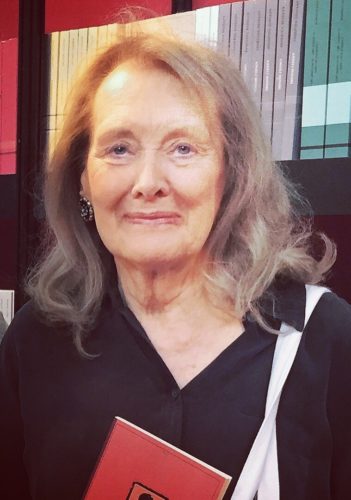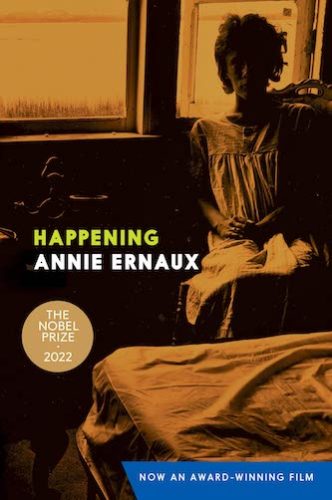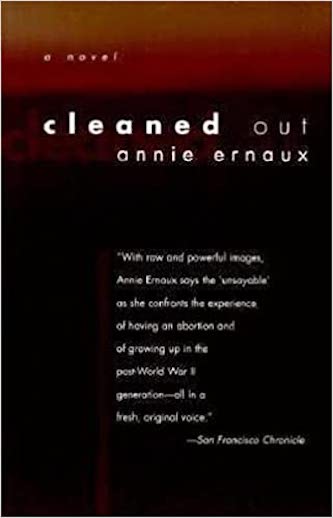Arts Commentary: Annie Ernaux, Abortion, and Me
By Pat Reber
What is literature if it doesn’t kick you in the ass every now and then and get you to act? Maybe that’s what the Nobel committee thought when it awarded Annie Ernaux this year’s Literature Prize.

Annie Ernaux in 2017. Photo: Wiki
The Nobel Literature Prize was presented December 7 in Stockholm, Sweden, to French writer Annie Ernaux, who at age 82 continues to write about how her life in French society is defined by her gender and her social class at birth. Her latest book to be translated into English, Look at the Lights, My Love, will be published by Yale University Press in April, 2023.
Annie Ernaux waited 37 years until she was 60 to write about her abortion, in L’Événement –Happening. Does it matter that it’s taken me 55 years to do the same? What is literature if it doesn’t kick you in the ass every now and then and get you to act? Maybe that’s what the Nobel committee thought when it awarded her this year’s Literature Prize.
She was 23, a student in Rouen, France, begging for help with her unwanted pregnancy. I was 20, an American student in Marburg, Germany, begging for help with the same.
The help we both found in the 1960s was in private apartments – a kitchen, a bedroom. Annie nearly died from blood loss. My abortionist was arrested, after one of her patients died.
As I read, I thought of the courage it took to write this book in 2000, even if her father had passed and her mother was no longer, presumably, examining her underpants for signs of her period. I can barely summon the courage to share my story with my grown children.
Annie takes the reader door to door as she visits doctors, waits in their waiting rooms, submits to the stirrups, finds an abortionist and delivers the fetus in her dorm room. What sets Happening apart from many published personal accounts of illegal abortion is her dispassion, despite the “maelstrom of emotions” she admits she feels when images of her own abortion rush in. She becomes “obsessed” with writing about it.
“I began this story one week ago, not knowing whether I would go through with it … Obeying this impulse seemed a terrifying prospect. On the other hand, I could die tomorrow without having done anything about it. If I were guilty of anything, it would be that,” she writes.
This was the kick to my ass.
Annie gets pregnant during a fling with a fellow student, using the rhythm method. She knows it might be risky but can’t imagine anything would happen. Likewise, I also thought I knew about the safe days. But flying in 1967 from Barcelona to Frankfurt after unprotected sex (was there any other kind in those days?), I picked up a newsmagazine article on birth control. My stomach sank. I had been counting from the WRONG DAY.
In those days, before the pill was widely available, condoms and diaphragms were the only means of contraception we knew about. Both were hard to come by – contraception was illegal in France. For long decades, women lived month to month looking for blood.
Annie writes in her diary every day: “NOTHING.” She takes in a Jean-Paul Sartre play. “Fantastic. If only I didn’t have this REALITY inside me.”
The REALITY is that she is the first in her family to attain university, and she won’t let a pregnancy stand in the way of finishing. She loves the sex but not the man who would be the child’s father. The REALITY of France in the ‘60s, when a woman who aborted faced criminal charges, takes her on a three-month plus odyssey. When she visits doctors, she can’t ask for an abortion, she can only ask them to make her period come. One doctor gives her medicine intended to prevent miscarriage. Another doctor congratulates her.
 A fellow male student comes through with a possible contact: a woman, LB, who worked at the editorial office of Paris-Normandie. Annie waits outside, sometimes for hours in the rain, but does not see the woman.
A fellow male student comes through with a possible contact: a woman, LB, who worked at the editorial office of Paris-Normandie. Annie waits outside, sometimes for hours in the rain, but does not see the woman.
As a student in Marburg, I asked for help from a medical student who lived in my dorm, pretending to speak on behalf of a friend. He couldn’t help. Finally, friends in Strasbourg helped me via a student who sold drugs and brokered abortions. By then, I was probably seven or eight weeks pregnant and, like Annie, convinced that it would just be a small procedure to stop it. What else were we to do?
Like Annie, I never considered the alternative: I could not imagine raising a child alone or marrying P, the father of the pregnancy, who was a CiA agent. I was a member of SDS and an anti-war protester. I couldn’t go home to my parents. Most importantly, like Annie, I was intent on finishing college and working as a journalist.
Like many of us who had illegal abortions, Annie convinces herself there was nothing to fear.
Weeks go by. Desperate, she grabs a pair of “two long, shiny blue [knitting] needles.” The pain stops her.
“I realize this account may exasperate or repel some readers … I believe that any experience, whatever its nature, has the inalienable right to be chronicled,” she writes in one of the parenthetical writerly ellipses that crop up in Happening.
Annie goes back to one of her doctors. This doctor gives her a prescription for 16 days of penicillin. “Don’t tell me where you’re going,” the doctor says.
Finally, when Annie is nearly three months along, the woman, LB, comes knocking at her door. LB gives her the address of a middle-aged paramedic, Mme P-R, in Paris – a woman she herself had used. The procedure would be insertion of a probe into the cervix, then a waiting period until one miscarried.
I cringe when I read this.

Pat Reber with child in stroller in pro-choice demonstration at U.S. Supreme Court, 1980s.
Annie needs 400 Francs for the abortion and travel money to get to Paris from Rouen. Like many women in the US today who travel hundreds of miles for an abortion, Annie has to scrape together the funds. To stretch her resources, she hitchhikes to Paris to meet the abortionist and set up a date. She must wait another week for the procedure. Mme P-R can only get the speculum on a Wednesday from the hospital where she worked.
On the appointed day, Annie travels back to Paris, stops at a café for tea to calm her nerves, then goes to the address. She climbs to the third floor. Mme P-R has prepared everything. Annie lays her upper body on a bed, with her hips and folded legs extended on a table covered with a white towel.
“I feel that the woman who is busying herself between my legs, inserting the speculum, is giving birth to me,” Annie writes. “At that point I killed my own mother inside me.”
Annie screams at the “blinding pain.” Mme P-R insists she stop screaming.
That clandestine climb up the stairs, that woman at the door, that table, brought me up short. Suddenly, it was 1967, and I was climbing up two flights of stairs in Strasbourg, alone, knocking on a door. It is dark. My legs are shaking. I am directed to walk to the kitchen through the bedroom of her sleeping children. I speak no French, she little English. We settle on German. “Ruhe, die Kinder schlafen,” she says. Quiet, the children are sleeping. I lay down on the table, barely long enough for my body and bent knees. Did she put a towel in my mouth to shut me up? I can’t remember.
My abortionist injects a saline solution into my uterus, stuffs my vagina with cotton and sends me on my stumbling way, back down the stairs to where P is waiting for me with a car. I must wait to expel the fetus.
Annie’s abortion doesn’t work. She returns to Paris for a second probe. Five days later, in her dorm, the contractions come. A friend guides her to pant between contractions. Seized by the urge to defecate, she walks to the bathroom and delivers the fetus. “I saw a baby doll dangling from my loins at the end of a reddish cord,” she writes. “We look at the tiny body with its huge head, the eyes two blue dashes beneath translucent lids.” There is crying. The friend cuts the cord.
Throughout such painful bloodiness, Annie maintains her distance as if observing from afar. This is her power as a writer, recounting her own life. “When I write, I must guard against lyrical outbursts such as anger or pain. I would not want crying and shouting to feature in this text because they barely featured in my life at the time,” she writes.
Nonetheless, she punctuates Happening by noting the difficulties of reconstructing facts from memory and drawing on traumatic images of real experience. She uses her diary to reconstruct dates but she emphasizes that the mental images from her abortion are also proof “that I truly experienced such events in this particular manner.” [Emphasis hers.]

This character of her work was noted by the 2022 Nobel Prize committee, bestowing the literature award for “the courage and clinical acuity with which she uncovers the roots, estrangements and collective restraints of personal memory.”
In Annie’s abortion aftermath, she is bleeding profusely and is sent to hospital. She is subjected to verbal abuse and moral condemnation along the way, starting with the emergency doctor up to the surgeon who shouts at her, “I’m no fucking plumber.” Medical staff treat her harshly until they realize she is an academic – a reflection of prevailing class and social discriminations that infuse many of Ernaux’s writings.
I do not remember how long it took for me to expel the fetus. My bleeding stopped, I took a long bike tour of several days with some friends in Hesse, traveled to see a cousin. I felt great relief when a small mass came out after I thought I was getting my period. I did not realize until years later that I, like Annie, could have died.
Was it worth the risk for Annie and me?
In 1974, Annie published her first book, Cleaned Out, a novel that deals with the after-effects of an illegal abortion and addresses broader aspects of French society and class restrictions. That same year, I returned to Germany and got involved in the effort by German women to dismantle Paragraph 218 of the German criminal code – a ban on abortion dating back to 1871.
Annie later raised two sons. I raised three children. We were both able to live the lives we had prepared for in our teens and 20s. Every woman should be able to do this. But many women still cannot.
To paraphrase Annie Ernaux, “thousands of girls” are still climbing up stairs and knocking on a door “answered by a woman who is a complete stranger, to whom they are about to entrust their stomach and their womb.”
Editor’s Note: Globally, an estimated 121 million unintended pregnancies occur per year, according to a 2015-2019 study by the Alan Guttmacher Institute. Of these unintended pregnancies, 61 percent – or 73 million – ended in abortion. https://www.guttmacher.org/sites/default/files/factsheet/fb_iaw.pdf
Pat Reber, 75, a retired journalist living in Maryland, has worked as a reporter and editor in New York, Washington DC, Germany, Kenya and South Africa. She covered the Truth and Reconciliation Commission hearings in South Africa for the Associated Press and served as deputy bureau chief in Washington for Deutsche Presse-Agentur (dpa) during the Bush and Obama years. This is the first time she has written about the trauma of an illegal abortion for publication.
Tagged: Abortion, Annie Ernaux, Happening, Nobel Prize in Literature

Thank you for this revelation about what I call the collective ‘sorrow’ within the human species. And after all the details you present to end the article with the 2015-2019 abortion statistics was also SHOCKING.
Here in the US voters are making themselves heard on the right to abortion issue BUT I am a 70 yr old, self employed earth scientist who has worked for 55 years (so consider myself ~informed) AND the abortion statistic SHOCKED me. How in this day and age can there still be that many abortions contributing to a collective sorrow. That is going to get my focus.
Thank you Rose for your response. For many girls and women who are unintentionally pregnant, sometimes after using contraceptives, the decision to abort is an existential one. If you follow the link to the Guttmacher study, it shows that in places where abortion is legal and sanitary and contraception widely available, the abortion rate fell. The West African country of Benin, for example, widened abortion access a year ago at the behest of gynecologists who found the death toll from illegal abortions was unacceptable. As a result, the death toll for women has fallen. (New York Times, November 13, 2022)
This exchange between Pat Reber and Annie Ernaux is amazing. Two abortion stories happening. just 4 years apart two lives that could have been lost in so many ways. Reber has the same kind of quiet force as Ernaux — mind and emotions totally focused , no words wasted. I’ve taught Ernaux’s book to graduate and undergraduates students. It shocks and (in a good way) overwhelms. From now on I will always teach it with Pat Reber’s commentary.
Thank you for this.
I take heart that you are teaching this book to younger generations of students – and that my commentary will broaden their understanding of the way things were and how they may become yet again. I was struck by Ernaux’s “writerly asides”, which reminded me of your own Constructing a Nervous System.
My grandmother had an abortion in the early 1920s in Springfield, Ohio, and never spoke about it until her 80s, just before she died. She was far enough along to know that she would have given birth to a son. I can’t presume the pain she went through with such a late abortion but the emotional trauma clearly stayed with her her whole life, as supported by Reber’s harrowing account here of her own abortion and Ernaux’s. Why, 100 years later, are we back to square one in this country? Women looe their ability to control their destinies if they don’t have access to birth control and safe abortions. Where are we? This has to change.